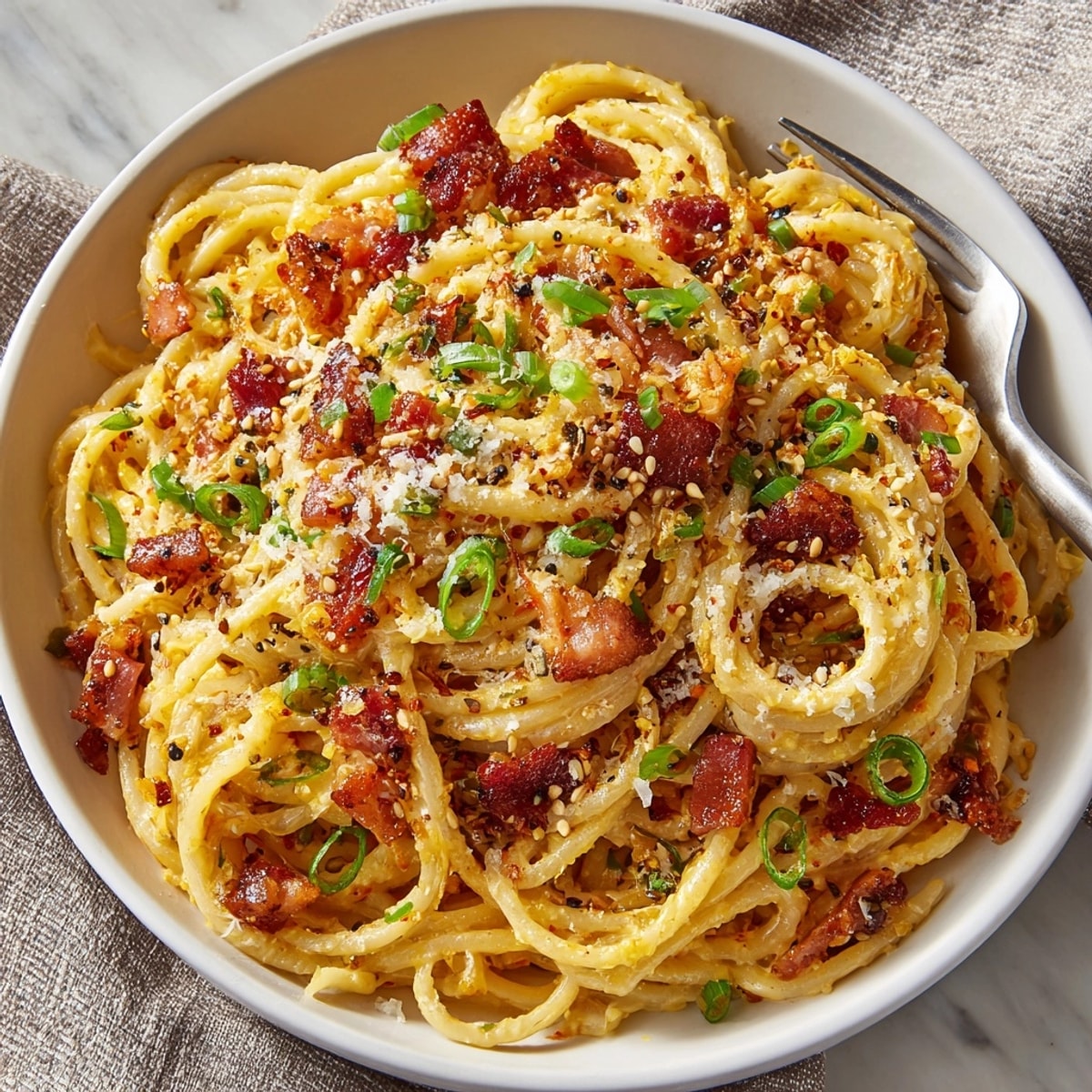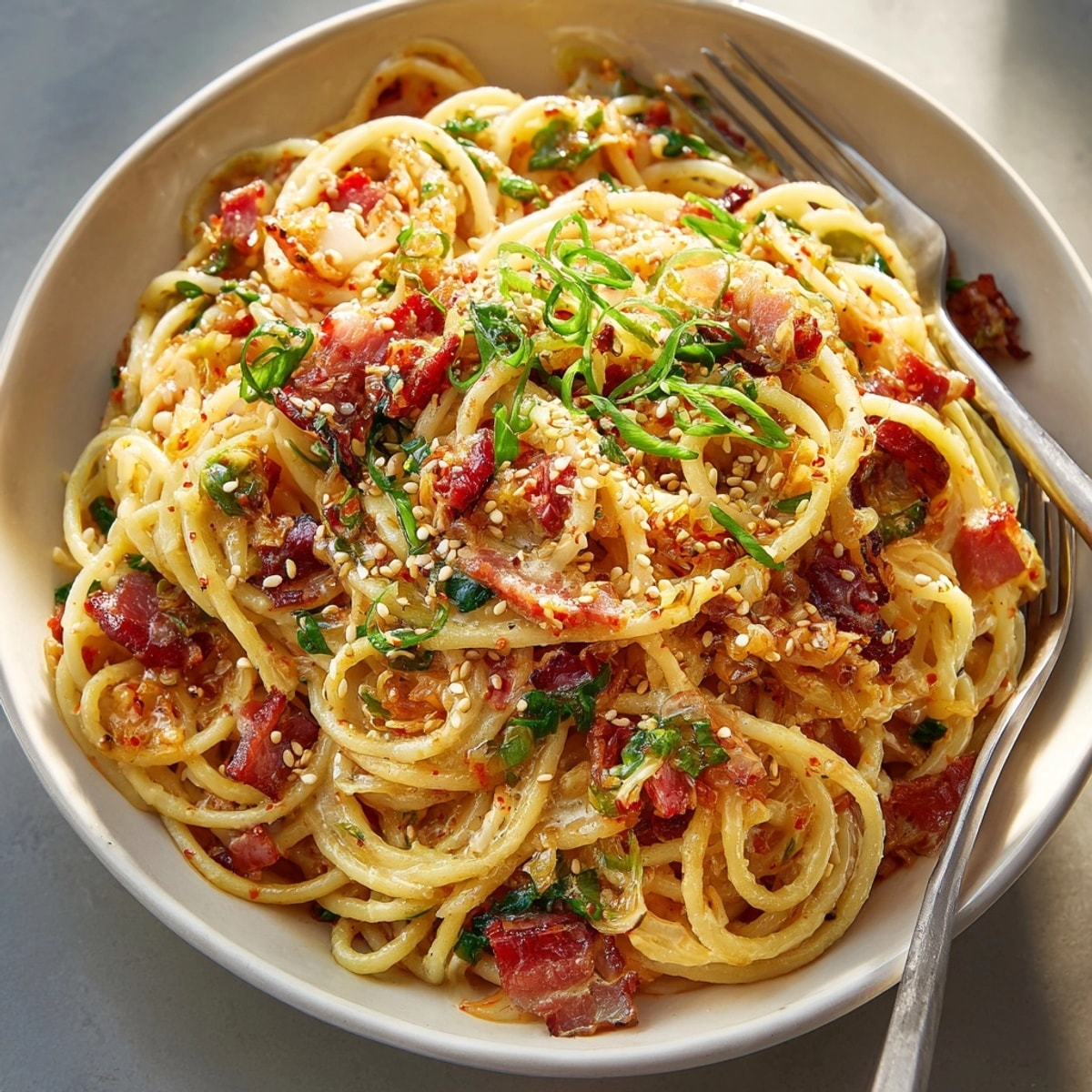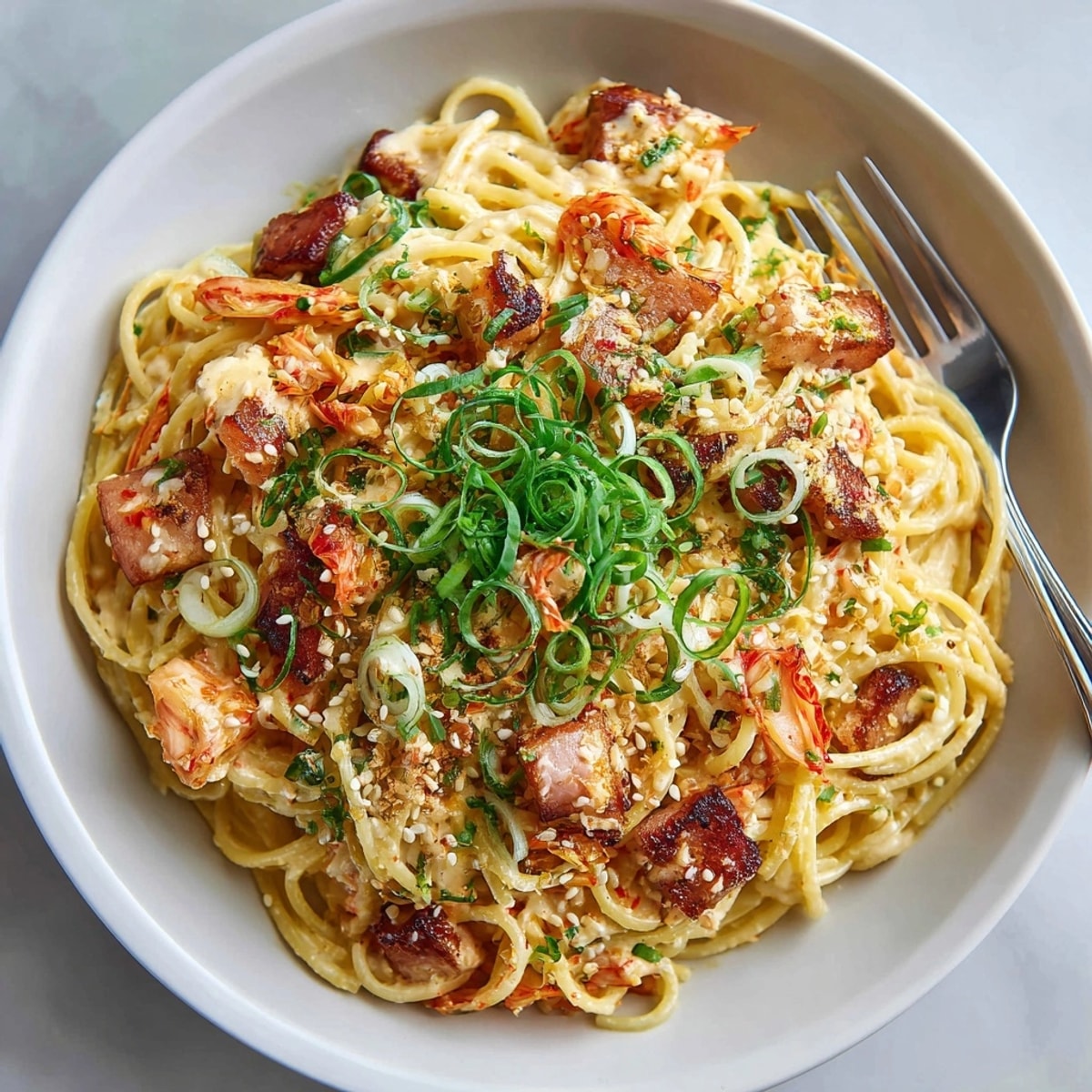 Save
Save This Korean Kimchi Carbonara with Sesame Oil Drizzle transforms the classic Italian pasta dish into something extraordinary. The tangy fermented kimchi adds complexity to the creamy carbonara sauce, while a finishing drizzle of nutty sesame oil creates a fusion masterpiece that bridges Italian and Korean cuisines beautifully.
I first created this dish when craving both Italian comfort food and Korean flavors during a particularly cold winter evening. What started as kitchen experimentation has become my signature dish when hosting friends who appreciate bold flavors.
Ingredients
- spaghetti or linguine: 400g The long strands perfectly capture the creamy sauce and kimchi bits
- large eggs: 3 Form the base of the silky carbonara sauce look for free range for best flavor
- grated Parmesan cheese: 80g Provides saltiness and umami use authentic Parmigiano Reggiano for best results
- pancetta or thick cut bacon: 120g Adds essential smoky fat and protein choose thicker cuts for better texture
- well fermented kimchi: 150g The star ingredient that brings tang and heat older kimchi has deeper flavor
- toasted sesame oil: 2 tbsp Creates the distinctive nutty finish that elevates this fusion dish
- kimchi juice: 1 tbsp Adds concentrated fermented flavor without extra bulk
- heavy cream: 60ml Optional but creates an extra silky texture and helps prevent egg curdling
Instructions
- Prepare the Pasta:
- Fill a large pot with water adding 1 tablespoon salt per liter. Bring to a rolling boil before adding pasta. Cook until al dente usually 1 minute less than package directions suggest. Before draining reserve 120ml of starchy pasta water this is crucial for achieving the proper sauce consistency. Drain pasta but do not rinse to preserve the starch that helps sauce adhere.
- Create the Sauce Base:
- In a medium bowl whisk eggs vigorously until slightly frothy. Add grated Parmesan and optional cream continuing to whisk until thoroughly combined. Season generously with freshly ground black pepper. This mixture should be ready before cooking pasta to allow immediate tossing while pasta is hot.
- Render the Pancetta:
- Heat a large skillet over medium heat and add butter. Once melted add diced pancetta or bacon spreading evenly across the pan. Cook for 4 to 5 minutes stirring occasionally until fat renders and meat becomes crispy but not burnt. The fat released will become a flavorful base for the sauce.
- Add Aromatics and Kimchi:
- Add minced garlic to the rendered pancetta cooking for just 30 seconds until fragrant but not browned. Immediately add chopped kimchi and kimchi juice stirring to combine. Sauté for 2 to 3 minutes allowing the kimchi to soften slightly and its flavors to infuse the fat.
- Combine and Create the Sauce:
- Working quickly add drained hot pasta to the skillet tossing with tongs to coat with the pancetta and kimchi mixture. Remove from heat and let cool for exactly 1 minute this prevents scrambled eggs but keeps enough heat to cook the sauce. Pour egg mixture over pasta while continuously tossing to create a smooth creamy coating. If sauce seems too thick gradually add reserved pasta water until reaching desired silky consistency.
- Finish with Sesame Elements:
- Drizzle sesame oil over the pasta and toss gently to distribute. Transfer to warmed plates or a serving bowl and immediately garnish with toasted sesame seeds and sliced spring onions. Serve right away while the sauce is at its creamiest.
 Save
Save The kimchi is truly the heart of this dish. I discovered that well aged kimchi with at least 2 weeks of fermentation provides the best flavor profile. My Korean neighbor actually taught me that squeezing extra kimchi juice directly from the jar adds an incredible depth that transforms this fusion dish from good to unforgettable.
Storage and Reheating
Carbonara is traditionally best enjoyed immediately after preparation as the creamy sauce can separate when refrigerated and reheated. However if you must store leftovers place them in an airtight container in the refrigerator for up to 2 days. To reheat add a splash of water or cream to a skillet over low heat and gently warm the pasta stirring constantly. The texture will not be as silky as freshly made but the flavor remains delicious.
Smart Substitutions
For a vegetarian version replace pancetta with 200g of king oyster or shiitake mushrooms sliced and deeply browned in butter. The mushrooms provide similar umami richness without meat. Pescatarians might enjoy adding 150g of small cooked shrimp instead.
If kimchi is unavailable in your area you can substitute with 100g sauerkraut mixed with 1 teaspoon gochugaru Korean chili flakes. While not identical this provides similar tangy fermented notes with customizable heat.
For a gluten free option use rice noodles or gluten free spaghetti but be aware the starch content differs so you may need less pasta water for the sauce consistency.
Cultural Context
This dish beautifully represents modern fusion cuisine that honors both Italian and Korean culinary traditions. Traditional carbonara originated in midcentury Rome using ingredients American soldiers brought during WWII. Meanwhile kimchi has been a staple of Korean cuisine for centuries with incredible health benefits from fermentation.
The addition of sesame oil bridges these worlds creating a dish that feels both innovative and somehow familiar. The combination works because both culinary traditions value simplicity with high quality ingredients and balanced flavors.
Serving Suggestions
Pair this rich pasta with a simple side salad dressed with rice vinegar and a touch of the same sesame oil used in the pasta for flavor continuity.
For an impressive dinner party serve small portions as a first course before a main of grilled fish or bulgogi.
Complete the fusion theme with a drink pairing of chilled sake or a crisp Asian lager which complement both the creaminess and spice.
 Save
Save This dish is a testament to how two distinct culinary worlds can harmonize beautifully. Enjoy this unique and deeply satisfying pasta creation.
Recipe FAQ Section
- → Can I use a different type of pasta?
Yes, any long pasta such as linguine or fettuccine works well for holding the creamy, flavorful sauce.
- → Is there a vegetarian option?
Omit pancetta or bacon and substitute with sautéed mushrooms for satisfying texture and depth.
- → How spicy is the dish?
Spice level depends on the kimchi used. Adjust quantity for preferred heat, or use milder kimchi.
- → What kind of kimchi should I use?
Well-fermented, chopped napa cabbage kimchi offers the best texture and flavor for this fusion dish.
- → Can I prepare this ahead of time?
This dish is best enjoyed immediately for creamy texture, but leftovers can be reheated gently.
- → What pairs well as a side?
A crisp green salad or light soup complements the bold flavors. Try with a dry white wine or lager.